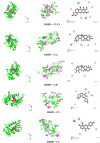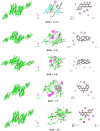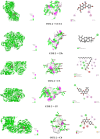First-time report on compound isolation from two Colocasia species: vegetable-derived bioactive metabolites and their medicinal potential
- PMID: 39697535
- PMCID: PMC11652197
- DOI: 10.3389/fphar.2024.1474706
First-time report on compound isolation from two Colocasia species: vegetable-derived bioactive metabolites and their medicinal potential
Erratum in
-
Corrigendum: First-time report on compound isolation from two Colocasia species: vegetable-derived bioactive metabolites and their medicinal potential.Front Pharmacol. 2025 Apr 11;16:1541225. doi: 10.3389/fphar.2025.1541225. eCollection 2025. Front Pharmacol. 2025. PMID: 40290441 Free PMC article.
Abstract
Background: Colocasia affinis Schott and Colocasia gigantea Hook.f. are two commonly found vegetable species of the genus Colocasia, found mainly in the Asian region.
Objectives: The objective of this study was to isolate bioactive phytochemicals from C. affinis and C. gigantea and elucidate their structure employing the NMR technique followed by bioactivity evaluation.
Methodology: Column chromatography was utilized to isolate phytochemicals, followed by NMR analysis for characterization. An in vivo analgesic test was performed through an acetic acid-induced writhing test, an anti-inflammatory test was performed through a formalin-induced licking test, and an antidiarrheal test was performed through a castor oil-induced diarrhea model. The in vitro antimicrobial test was executed through the disc diffusion method. Computer-aided simulation was also implemented to validate the wet laboratory results.
Results: Six compounds from C. affinis and C. gigantea were isolated and characterized from the dichloromethane (DCM)-soluble fractions of the methanolic extracts of these two species. Three of the compounds were from C. gigantea and proposed as penduletin (C1), a mixture of α-amyrin (C2a), β-amyrin (C2b), and monoglyceride of stearic acid (C3), while the remaining three compounds were from C. affinis and proposed as penduletin (C4) (which was also isolated from C. gigantea), 7,8-(3″,3″-dimethyl-pyrano)-4'-hydroxy flavonol (C5), and lastly a mixture of 7,8-(3″,3″-dimethyl-pyrano)-4'-hydroxy flavonol (C5) and 4',7,8-trihydroxy flavonol (C6). These compounds showed promising zones of inhibition against Gram-positive and Gram-negative bacteria and fungi. In the antidiarrheal test, C5 demonstrated the highest reduction in castor oil-induced diarrhea (44.44%) at a dose of 20 mg/kg compared to loperamide's 77.78% reduction. However, the analgesic assessment showed a noteworthy inhibition of acetic acid-induced writhing by C1/C4 and C2 (56.52%) at a dose of 20 mg/kg compared to the 76.09% by diclofenac sodium. In comparison, C2 showed pronounced anti-inflammatory action by 68.15% and 52.06% reduction, respectively, in the early and later phases compared to the ibuprofen's outcomes of 73.54% and 74.68%. Plausible targets such as dihydrofolate reductase (DHFR) for antimicrobial, kappa opioid receptor (KOR) for antidiarrheal, and cyclooxygenase 2 (COX-2) for anti-inflammatory and analgesic activities showed a noteworthy binding affinity with isolated compounds, and ADME/T studies displayed these phytochemicals' drug-likeness profiles.
Conclusion: To the best of our knowledge, this is the first report on compound isolation from these plants, which demands further extensive research for more absolute findings.
Keywords: Colocasia affinis; Colocasia gigantea; NMR; analgesic; anti-inflammatory; antibacterial; antidiarrheal; vegetable.
Copyright © 2024 Alam, Richi, Emon, Chowdhury, Hasan and Haque.
Conflict of interest statement
The authors declare that the research was conducted in the absence of any commercial or financial relationships that could be construed as a potential conflict of interest.
Figures












Similar articles
-
Chemico-pharmacological evaluations of the dwarf elephant ear (Colocasia affinis Schott) plant metabolites and extracts: health benefits from vegetable source.Front Pharmacol. 2024 Aug 13;15:1428341. doi: 10.3389/fphar.2024.1428341. eCollection 2024. Front Pharmacol. 2024. PMID: 39193333 Free PMC article.
-
Antidiarrheal, antimicrobial and antioxidant potentials of methanol extract of Colocasia gigantea Hook. f. leaves: evidenced from in vivo and in vitro studies along with computer-aided approaches.BMC Complement Med Ther. 2021 Apr 12;21(1):119. doi: 10.1186/s12906-021-03290-6. BMC Complement Med Ther. 2021. PMID: 33845836 Free PMC article.
-
Corrigendum: First-time report on compound isolation from two Colocasia species: vegetable-derived bioactive metabolites and their medicinal potential.Front Pharmacol. 2025 Apr 11;16:1541225. doi: 10.3389/fphar.2025.1541225. eCollection 2025. Front Pharmacol. 2025. PMID: 40290441 Free PMC article.
-
Metabolite profiling, anti-inflammatory, analgesic potentials of edible herb Colocasia gigantea and molecular docking study against COX-II enzyme.J Ethnopharmacol. 2021 Dec 5;281:114577. doi: 10.1016/j.jep.2021.114577. Epub 2021 Aug 28. J Ethnopharmacol. 2021. PMID: 34464698
-
Medicinal plants of the genus Anthocleista--A review of their ethnobotany, phytochemistry and pharmacology.J Ethnopharmacol. 2015 Dec 4;175:648-67. doi: 10.1016/j.jep.2015.09.032. Epub 2015 Nov 11. J Ethnopharmacol. 2015. PMID: 26432351 Review.
References
-
- Abdel Motaal N. A. R., Abdel Maguid A. (2005). Effect of fractionated and single doses gamma irradiation on certain mammalian organs. Egypt. J. Hosp. Med. 19, 111–122. 10.21608/ejhm.2005.18115 - DOI
-
- Alam M. M., Emon N. U., Alam S., Rudra S., Akhter N., Mamun M. M. R., et al. (2021a). Assessment of pharmacological activities of Lygodium microphyllum Cav. leaves in the management of pain, inflammation, pyrexia, diarrhea, and helminths: in vivo, in vitro and in silico approaches. Biomed. Pharmacother. 139, 111644. 10.1016/j.biopha.2021.111644 - DOI - PubMed
LinkOut - more resources
Full Text Sources
Research Materials
Miscellaneous

